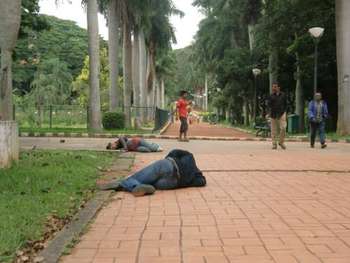All the world’s a stage…
And all the men and women merely players
These lines from Shakespeare’s ‘As you like it’ goes beyond the conventional definitions of a performance space. In a regular theatre (proscenium), a transparent wall exists between the audience and the performers. The illusion is based on creativity, sound, lights, music and set design. The audience are mute spectators – they can only travel with the performers on the emotional journeys.
Contemporary artistes try to take performance beyond ‘a show’ and recreate life through different mediums in real space.
Deepak K Shivaswamy in collaboration with dancers of Bangalore Dance Collective, a Bangalore based contemporary dance group, created one such performance. Shivaswamy, a Bangalore based dancer and choreographer, trained in contemporary dance at the Attakkalari Centre for Movement Arts who has worked extensively in Europe, devised ‘Area’, inspired by the liveliness and action in our city’s public space.

Area, a contemporary dance performance choreographed by Deepak Shivaswamy. Pic: Veena Basavarajaiah.
On September 5th, the dancers met at Jaaga, a space for screenings, workshops, lectures and performances in Shantinagar. They then took the audience on a journey (literally) on different streets of Shanthinagar.
The performance attracted about 20-25 people, and as the performance wound its way through the streets and parks, the audience changed, with curious onlookers joining in and others dropping out. The performers and the audience experienced the landscape of the city and the related issues, the lack of pavements, the encroachments on roads, the gargantuan corporate towers and the slums of the poor.
The architectural diversity within a radius of one kilometre surfaced beautifully as the four dancers Deepak, Mirra , Rakesh M P S and Hema Sundari Vellaluru moved dressed in ordinary clothes. The moved through IT offices, traffic signals, parks, pavements, mosques, residential areas and at the end, parted ways , mounting their bikes and driving away to end the performance. Pre-recorded instructions were streamed into their ear phones so the performers could keep in sync with each other.

Area, a contemporary dance performance choreographed by Deepak Shivaswamy. Pic: Veena Basavarajaiah.
The dancers kept a straight face and moved like pedestrians, suddenly breaking into a fall or dancing in frenzy. Unlike street performances, there was no loud music being played or elaborate movements. Mundane movements like jogging, walking, sleeping when done in different context, space and texture drew the audience’s attention transforming a public space into a performance space. The onlookers reacted uniquely weaving themselves into the act as performers for us, the audience.
With the journey from one street to another, these onlooker-performers kept changing, adding diverse expressions of fascination, embarrassment, concern, amusement or remiss.
This choreography in public space was originally conceptualized by international choreographers Domenico Giustino, Jule Flierl, Tommy Noonan along with Shivaswamy while he worked in Austria. Their next venture is to present this piece across four different cities and time zones at the same time in November 2010.
When performance is taken to your private room or a public space, the end results is always dynamic. ‘Area’ managed to challenge an artist beyond rehearsed lines and set choreography exposing him to unpredictable situations as a perfect test for spontaneity and creativity.
When the audience becomes part of the performance, the performer cannot hide behind lights, make up, music or elaborate costumes anymore. When there is no room for artificiality, then we can understand art is an extension of life itself.
Attention: Young choreographers
This a call for applications for young choreographers
The Attakkalari Centre for Movement Arts, Bangalore, India, is calling for applications for an Interdisciplinary Young Choreographers Platform to be held in Bangalore, India, at the Attakkalari India Biennial 2011 between January 28 and February 6, 2011. Submission Deadline: 30th September 2010
Ph: 42039291/22123684; www.attakkalaribiennial.org
Music performances
Allied Ragas- 5, a thematic music programme series on ragas. Focus on ragas Sahana, Malavi and Dvijavanti by Vidwan D Balakrishna accompanied by Vidwan A Renukaprasad on the Mridanga.
September 26th 10 am – 1.30 pm at Ananya Sabhangana
Release of Vipanchi Vaibhava, written by Prof V Amrutha, daughter of legendary Vainika Venkatagiriyappa
10 am, Sunday, October 3 · 10 am – 12 pm, Ananya Sabhangana, 4th Main, Between 11th and 13th Cross, Malleswaram
Sharing ideas and dancing
Bangalore Dance Collective invites all the performing artists of Bangalore to be a part of an exciting afternoon of idea sharing and dancing.
Sunday, September 26th, 12 pm – 4 pm, Kalari Academy of performing Arts at Brigade Road ,Bangalore
⊕